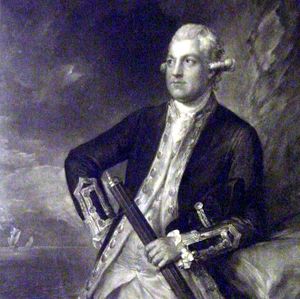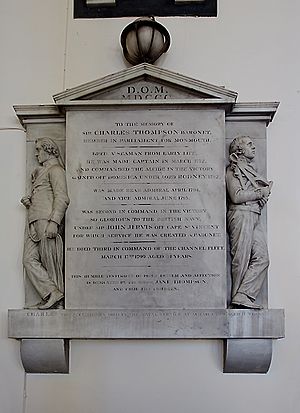Sir Charles Thompson, 1st Baronet facts for kids
Quick facts for kids
Sir Charles Thompson,
1st Baronet |
|
|---|---|

by Richard Earlom after Thomas Gainsborough
|
|
| Born | c.1740 |
| Died | 17 March 1799 (aged 58–59) Fareham |
| Allegiance | |
| Service/ |
|
| Years of service | 1755–1798 |
| Rank | Vice admiral |
| Battles/wars | |
| Awards | Baronetcy (1797) |
| Relations | Sir Norborne Charles Thompson, 2nd Baronet Sir Henry Thompson, 3rd Baronet |
Sir Charles Thompson (born around 1740, died 17 March 1799) was a brave British naval officer. He served for many years in important wars, including the Seven Years' War, the American War of Independence, and the War of the First Coalition. He was the second-in-command to Admiral John Jervis at the famous Battle of Cape St Vincent.
However, during that battle, Thompson didn't follow one of Jervis's orders. This almost caused problems and led to a disagreement between them. This disagreement, along with his declining health, eventually led to Thompson's retirement from the navy. From 1796 to 1799, he also served as a MP for Monmouth.
Contents
Early Life and Family
Charles Thompson's father is believed to have been Norborne Berkeley, who later became Baron Botetourt. Norborne Berkeley was the governor of Virginia. Charles's mother was Margaret Thompson. Charles, his mother, and his sister Elizabeth were all mentioned in Norborne Berkeley's will.
In 1783, Charles married Jane Selby. She was the daughter of Robert Selby from Bonnington, near Edinburgh. Charles and Jane had several children:
- Norborne Charles (1785–1826): He joined the navy but faced issues.
- Charles Robert (1788–1801): He died at sea when he was 13 years old.
- Elizabeth (born 1790)
- Jane (1794–1815): She passed away in Portugal at age 21.
- Henry (1796–1868)
Charles Thompson first worked on a merchant ship. But he soon joined the Royal Navy in 1755. This was just before the Seven Years' War began.
Early Service and Promotions
For the next five years, he served on ships like HMS Nassau, HMS Prince Frederick (1679) (Prince Frederick), and HMS Achilles. In 1760, he passed his test to become a lieutenant. He became the fifth lieutenant of HMS Arrogant in January 1761. He served with the Channel Fleet and then in the Mediterranean Sea.
After the war, his ship was taken out of service. Thompson then moved to the sloop HMS Cygnet. He served on the North American station from 1763 to 1768.
Commander and Captain
Thompson returned to North America in 1770 as the first lieutenant of HMS Salisbury. In February 1771, he was promoted to commander. He commanded the sloop HMS Senegal. After three months, he became acting captain of HMS Mermaid. He sailed this ship back to England in December 1771. Although his acting captain role wasn't officially confirmed, he was promoted to full captain on 7 March 1772. He then commanded HMS Chatham.
Service in the West Indies
Thompson sailed to the West Indies commanding HMS Chatham. This ship was the flagship for Vice-Admiral William Parry. Thompson later moved to the frigate HMS Crescent. He returned to England in 1774.
In early 1776, he went back to the West Indies commanding HMS Boreas. There, he captured a French ship called Le Compas. He then escorted a group of merchant ships back to England in October 1777. He returned to the West Indies again in 1780.
During this time, Sir John Laforey was appointed to a shipyard in Antigua. Thompson disagreed with Laforey's authority, which started a long-running dispute between them. In the Caribbean, Sir George Rodney moved Thompson to the 74-gun ship HMS Alcide. Thompson commanded this ship throughout the American War of Independence. He took part in important battles like the Chesapeake and St Kitts. In April 1782, Thompson was also present at the Battle of the Saintes. This was a major victory for Sir George Rodney against the French. Thompson sailed Alcide back to England when the war ended.
In 1787, Thompson commanded HMS Edgar at Portsmouth. In 1790, he commanded HMS Elephant during a tense time with Spain. When the War of the First Coalition began in 1793, he was given command of HMS Vengeance. This was part of an expedition led by Sir John Jervis and Lieutenant-General Sir Charles Grey against French islands in the West Indies. As a commodore, he helped capture Martinique and Guadeloupe.
During this time, the disagreement between Thompson and Laforey started up again. This led to Laforey being recalled. Thompson was promoted to rear-admiral of the blue on 12 April 1794. He sailed back to England the next year with HMS Vanguard as his flagship. On 1 June 1795, he became a vice admiral, with his flag on HMS London.
Mediterranean Service and Retirement
Thompson was then given command of a group of ships blocking the port of Brest. Later, he was transferred to HMS Britannia. In this ship, he served in the Mediterranean Sea. He was second-in-command at the Battle of Cape St Vincent. During this battle, he did not follow Admiral Jervis's signal to change course. This nearly caused the British to lose the battle.
Jervis was very angry, but he decided not to make the issue public. So, later that year, both Thompson and Jervis were rewarded for their contributions to the battle. Thompson received a baronetcy, and Jervis became an earl.
Thompson continued serving in the Mediterranean for a while. However, another disagreement with Jervis, this time about a decision Jervis made regarding two sailors, gave Jervis a reason to ask the Admiralty to recall Thompson. After Thompson's death, Jervis described him as a "brave man, but the most cautious officer." He also noted that Thompson had the "manner of a rough seaman," often dressing simply in a sailor's shirt and straw hat.
After being recalled, Thompson was given a post in the fleet blocking Brest. He held this position until 1798, even though his health was failing. His poor health eventually forced him to stop serving and return to England in early 1799. He passed away later that year. He is buried in Holy Trinity Church in Fareham. His monument was created by the famous sculptor John Flaxman.
Political Role
Charles Thompson was elected as a MP for Monmouth in 1796. He held this position until 1799, but he did not attend parliament very often.


